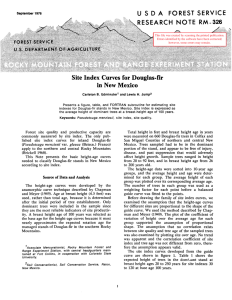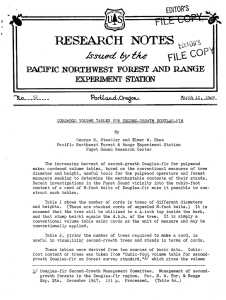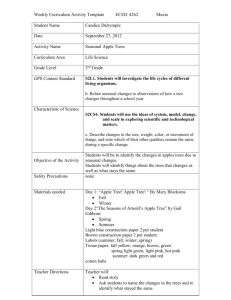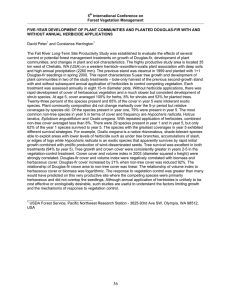Redcedar estern at Yiis'y'':,
advertisement
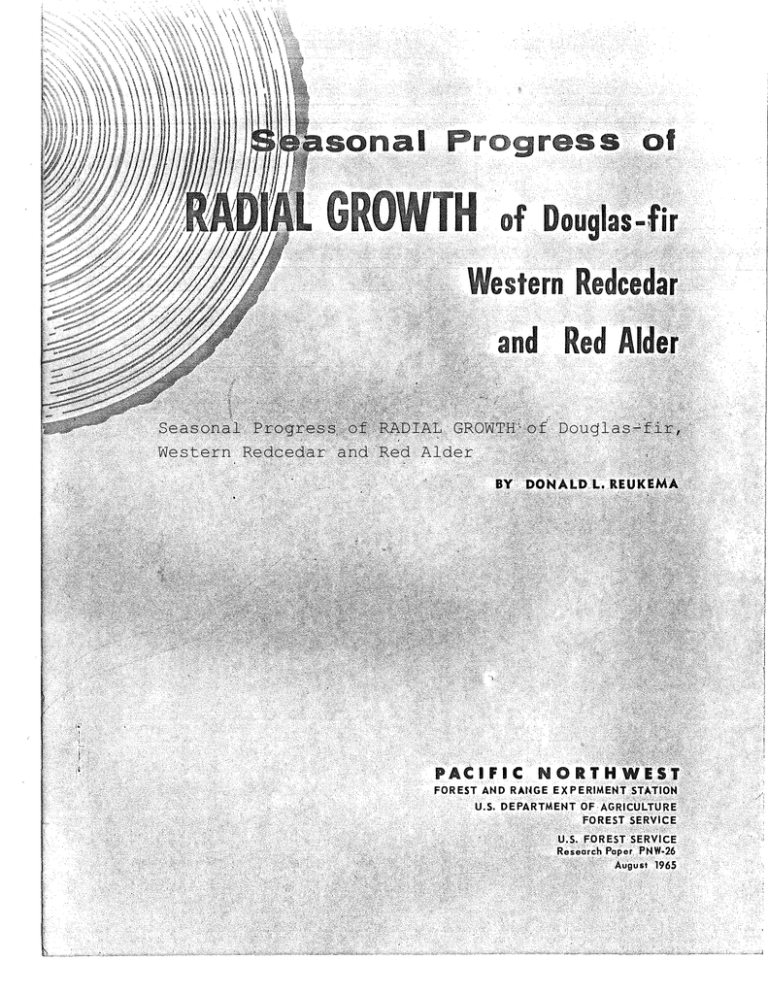
at
ss
'
'
. ·,· ' J' '' .:'
estern Redcedar
Seasonal Progress of RADIAL GROWTH of Douglas-fir,
Western Redcedar and Red Alder
PAC I F I C
N0 RT H
Yiis'y'':,
FOREST AND RANGE EXPERIMEifT
U.S.
STATION
DEPARTMENT OF AGRIClJLTlJ E
FOREST SE.RVIC.E
Resear h Paper, PNW-26
August
1965
INTRODUCTION To determine the duration of the growing season and the dis­
tribution of growth over the season, measurements of radial growth
were made for 5 years at McCleary Experimental Forest) in western
lt
.
Wash.1ngton,_
Information provided by this study should be of interest, not
only to those concerned with measuring short-term responses to
treatment or environment but also to those concerned with remeasur­
ing trees on permanent sample plots. Results clearly show progress
of growth over the season to be extremely variable from one year to
another. This makes it difficult to assess the proportion of total
growth completed by a given date and indicates the importance of
avoiding the growing season .. if at all possible, when periodic meas­
urements are made on permanent sample plots,
The literature contains many reports of similar measurements
on a widE/ numbe[ of the tree species (Bannan 1962 ; Bormann and
/
Kozlowsk 1962).- In many cases, measurements have been more
frequent and under better controlled conditions, but usually they have
covered only a 1- or 2 -year period, Also, few such measurements
have been made on the species herein reported, Dimock (1964) re­
ported observations on younger Douglas -fir in the same vicinity as
this study, and Warrack and Joergensen (1950) reported on measure­
ments to evaluate the effect of thinning on growth of Douglas-fir in
British Columbia.
THE S TUDY
Measurements were made on four groups of 10 trees each-­
two of Douglas-fir and one each of western redcedar and red alder.
One group of Douglas-fir trees (group 1) was near the top of a hill
on west-to-southwest aspect, at an elevation of about 57 5 feet; the
other (group 2) was on a moderatel westerly facing sidehill at an
elevation of about 37 0 feet. Cedar trees were on a flat at an elevation
/
.]_
McCleary Experimental Forest is maintained by the Pacific
Northwest Forest and Range Experiment Station in cooperation with
Simpson Timber Co. The study was begun by George R,. Staebler in
1954 and continued by Edward J, Dimock II.
.
/
3._ Names and dates in parentheses refer to Literature Cited,
p. 14.
of about 37 5 feet, and alders were on a flat at an elevation of about
3 3 0 feet. Douglas- fir trees were about 65 years old in 1954; cedar
and alder were about 50 years old.
- Trees were chosen to minimize variations in crown class and
diameter. Most were strong codominants. Starting diameters and
5-year radial growth are summarized in table l,
Table 1. --1954 d.b.h. and subsequent 5-year radial growth
(north side) of study trees
I
I
Tree
number'
Douglas-fir,
group
1
'
D.b.h.
Growth
Douglas-fir,
group 2
D.b.h.
I
Growth
I
Western
redcedar
I
I
D.b h.
•
I
I
,
i
Growth
Red alder
!j D.b.h. 1
I
Growth
--------------------------- Inc hes ---------------------------1
2
3
4
5
6
7
8
9
10
Average
15.6
17.1
15.7
16.6
18.9
15.9
16.4
15.3
15.4
17.5
0.312
.255
.383 '
.328
.372
.427
.804
.414
.432
.283
16.4
.401
15.9
22.7
17,3
17.5
20.8'
19.8
21.2
20.9
18.2
20.4
19.5
0.423
.567
.406
.107
.372
'.208
.721
.897
.320
.483
.451
I
10.3
10.5
11.6
10.9
8.4
10.5
10.6
9.5
9.3
10.0
0. 715
.284
.205
.442
.292
.428
.218
.393
.303
345
10.4
10.9
10.3
12.7
11.0
9.4
9.1
8.5
9.4
8.4
0.218
.256
.393
.287
.234
.311
.101
.212
.161
.110
10.2
.362
10.0
.229
•
Measurements were made in thousandths of an inch with a dial
gage dendrometer. Roundhead brass screws, driven into the wood of
the trees, were used for bearing points, and 3/ 8 -inch squares of
copper or aluminum, stuck to a smoothed portion of the bark with
fast-drying model airplane cement, were used for contact points,
The screws formed the corners of a r1ght triangle, so that no screw
was directly below the point where growth was measured.
2
Changes in radius were recorded cumulatively from the first
measurement in April 1954 to the final measurement in November
1958. During each growing season, measurements were made weekly
until it was established that true growth had been underway for at
east 2 weeks, and then every 2 weeks until growth apparently stopped.
In group 1, radius changes were recorded on four sides of the trees-­
north, east, south, and west. In all other groups, measurements were
made only on the north side of trees.
RESULTS AND DISCUSSION
Changes in radius due to moisture and the adequacy of meas­
uring trees on only one side are discussed first to provide a back­
ground for interpreting progress of seasonal growth. Variations in
precipitation and temperature are also present d to show their rela­
tionship to year-to-year differences in pattern of radial growtho
Changes n Radius Due to Moisture
Shrinking and swelling of tree trunks due to moisture changes
masks actual growth in many instances, and the reader should be
aware that reported changes in radius are the sum of true growth and
this shrinking or swelling -(Kozlowski 1962 )
.
Data collected during the early part of the 1956 growing season
from a setup on a recently dead tree showed the considerable impact
that moisture changes can have
The most drastic changes were
shrinkage of 0. 01 inch during the period April 6-2 0 and swelling of
the same amount during the period June 1-15; a hundredth inch is
about 15 percent of average annual growth on nearby living codominant
trees. The dead tree did not provide a completely valid measure of
shrinking and swelling due to moisture changes in live trees, but it
was indicative of the effect moisture alone can have
Substantial changes in radius between the last measurement in
the fall and first measurement the following spring are due in part to
swelling and shrinking. During the winters of 1954 -55, 1955-56, and
1957 -58, most trees showed sorne increase in radius, the increase
generally being greater on Douglas-fir than on cedar and alder. Be­
tween the 1956 and 1957 measurements, however, the north radius of
most trees shrank substantially--B. 5 percent of the 1956 seasonal·
growth for Douglas-fir, 18. 5 percent for cedar, and 30. 0 percent for
alder. Over the other three winters, increase in radius of Douglas­
fir averaged 6. 9 percent of the seasonal growth; cedar, 3. 2 percent;
and alder' 4. 6 percent.
3
Tree trunks also undergo small amounts of diurnal shrinking
and swelling, which could have sorne effect on changes from one me as­
urement to another (Kozlowski 1962). However, most measurements
were made in late morning, so this factor had negligible influence
except as reflected in the seasonal variation.
Adequacy of One Measurement Per Tree
On the 10 Douglas -fir trees where radial changes were meas­
ured on four sides, amount of annual growth differed substantially and
significantly between sides, as well as between years (table 2). Growth
averaged 42 percent greater on the east side than on the south side.
Table 2.--Average seasonal radial growth of Douglas- fir, by
side of tree and year (basis:
10 trees)
'
Year
North
East
South
West
side
side
side
side
------------------- Inches ---- - --------------
-
1954
0.089
0,087
0.057
1955
.102
.110
.081
.093
1956
.057
·.062
.043
.050
1957
.072
.082
.058
.061
1958
.076
'.077
.058
.056
.079
.084
.059
.067
Average
0.074
This relationship between growth rate and cardinal direction
may indicate a buildup in windfirmness in response to southwesterly
winds (Ruth and Yoder 1953), or it may otherwise b associated with
the near ridgetop position of these trees. Other factors--perhaps
relative competition on various sides of the tree, slope, root grafts,
etc. --sometimes overshadowed this trend.
Despite differences in amount of growth, progress of growth
during the season was very similar for all sides (table 3). The
4
Table 3.--Variation between sides of Douglas-fir trees in progress of seasonal radial growth
I
Year
Date 1954
1955 1956 1957
1958 Apr. 25
May 25
June 24
July 24
Aug. 23
Sept.22
I
I
Apr. 25
May 25
June 24
July 24
Aug. 23
Sept.22
Apr. 25
May 25
June 24
July 24
Aug. 23 Sept.22
Apr. 25
May 25 June 24
July 24
Aug. 23
SeDt.22
Apr. 25
May 25
June 24
July 24
Aug. 23
.
Sept.22
I
I
basis:
10 trees}
Percent of radial growth completed North
side
East
side
-5
11
40
65
88
99
. -6
10
41
67
90
99
10
20
48
74
93
' . 97
-5
.
South
side
-9
W,est
side
39
66
91
97
-7
8
39 64
90 99 8
19
. 49
75
94
98
10
21
53
79
95
98
7
19 51 77
94 98 -6
22
45
71
90
91
-13
16
43
65
86
87
-11 22 46 71 88
89 38
64
81
94
92
4
37
63
79
93
91
4
38
64
81
94
88
4
42
69 85
96 91 5
45
77
74
83
91
5
43
74
73
82
90
5
44
80
72
78
87
5
47
81 72· 80 87 "
25
51
78
93
93
5
.
<:?
3
5
average maximum deviation between sides, in percent of growth com­
pleted by any given date, was less than 5 percent; the greatest deviation
was 13 percent, In 1956, relative growth consistently progressed more
rapidly than average on the north side and less rapidly on the south side,
In l_ 957, relative growth progressed slightly more rapidly on the west
side. However, even these differences were fairly minor, and in other
years there were no consistent differences between sides.
Many minor differences between sides appear to be due pa'rtly
to shrinking and swelling. Apparent changes due to moisture were
generally of about the same magnitude on all sides, Therefore, when
these changes are expressed as percent of total seasonal growth, they
are relatively greater on sides making less than average growth,
Measurement on only one side of the stem is apparently suffi­
cient for determining progress of radial growth throughout the season,
although not for determining amount of growth.
I
'
Beginning and End of Growing Season
The time that growth begins in the spring and ends in the fall
can only be approximated, because of the masking effect of shrinking
and swelling. Generally, most of the true growth of all species appar­
ently took place between mid-April and early September. However,
there was considerable year-to-year variation (figs, 1-5 ),
For Douglas-fir, distinc_t turning points in the growth curves
marked the apparent start of growth about May 10 in 1954 and April 2 0
in 1956 and 1957 , In 1955 and 1958, growth apparently started in
early ApriL Growth of cedar and alder apparently started about 3
weeks earlier than Douglas-fir in 1954; growth of alder started about
a month later than Douglas-fir in 1958.
The period of rapid growth of Douglas-fir ended about Sep­
tember 15 in 1954; August 15 in 1955, 1956, and 1957 ; and June 25 in
1958, However, only in 1954 was growth completed by the date indi­
cated. In 1955, a slow increase in radius continued to the last meas­
urement in mid-October. In other years, there were irregular changes
in radius, with some growth apparently taking place into October and,
perhaps, November, Corresponding dates for ·other species differed
only slightly.
6
PERCENT
100
90
80
70
60
50
40
30
20
TOTAl SEASONAl GROWTH
10
DOUGLAS-FIR ( group 1, average
-10
SEPT.
AUGUST
Figure
].
of four sides ) Seasonal distribution of radial growth on Douglas-fir ( group 1, average of four sides ) , 1954-58.
••
PERCENT
100
90
80
'70
60
50
40
30
20
TOTAl SEASONAl GROWTH 10
DOUGLAS-FIR
( group 1, north
0
-10
24
9
JUNE
9
24
JULY
B
28
AUGUST
side ) 7
22
SEPT.
7
22
OCT.
6
21
NOV.
Figure 2.--Seasonal distribution of radial growth on Douglas-fir (group 1, north side), 1954-58.
7
PERCENT
!CO r90
80
70
60
50
40
30
20
TOTAl SEASONAl GROWTH
10
DOUGLAS-FIR
( group
-10
10
25
APRIL
10
25
24
9
JUNE
MAY
24
9
2,
north side )
28
8
AUGUST
JULY
Figure 3.--Seosonol distribution of rodiol growth on Douglas-fir ( group
2,
7
22
7
22
6
OCT.
SEPT.
21
NOV.
north side), 1954-58.
PERCENT
100
90
80
70
60
50
40
30
20
TOTAl SEASONAl GROWTH
10
WESTERN REDCEDAR
( north side )
-10
10
25
25
10
MAY
24
9
JUNE
24
9
JULY
8
28
AUGUST
7
22
SEPT.
Figure 4.--Seosonol distribution of rodiol growth on western redcedor ( north side), 1954-58.
8
7
22
OCT.
21
6
NOV.
PERCENT
100
90
/
80
70
60 50 40 30 20 TOTAL SEASONAL GROWTH
10 RED ALDER
( north side )
-10
10
25
APRIL
25
10
MAY
Figure 5.--Seasonal distribution of radial growth on red alder ( north side
),
1954-58.
Distribution of Growth Over the Season
The distribution of growth qver the season is perhaps most
easily visualized when growth to any given date is expressed as a
percent of the total seasonal growth (figs. 1-5 ). For illustrative
purposes, the growing season has been taken as the period from the
first measurement to the highest reading. The trend lines show
actual growth plus or minus changes due to shrinking and swelling.
Since there was some growth between measured periods, the indi­
cated percent of total growth completed by a given date would differ
somewhat if measurements had been taken over a longer or shorter
period, but the impact on the total curve would not be appreciable.
Relative growth distribution for each year is summarized in
table 4 for Douglas-fir in group 1 (average of four sides) to further
illustrate differences between years. On the average of the 5 years,
growth was 2 7 percent complete by May 25. However, this varied
from 8 percent in 1954 to 45 percent in 1958. Similarly, growth com­
pleted by June 25 averaged 57 percent but varied from 40 to 79 per­
cent.
9
Table 4.-- Seasonal distribution of growth for Douglas-fir,
group 1 (average of four sides) , by years
Date
1954
1955
1956
1957
1958
Average
,
----------- Percent of total seasonal growth -----------Apr.
May
June
July
Aug.
Sept,
Oct.
Nov.
25
25
24
24
23
22
22
21
-7
8
40
64
90
99
9
20
50
76
95
98
-9
23
48
73
89
89
100
5
38
67
82
95
92
100
5
45
79
73
81
90
96
100
1
27
57
74
90
94
99
100
Even during the generally most active part of the growing
season, shrinkage sometimes offset or exceeded growth. The most
notable example was during the period June 24 through August 15, 1958.
On Douglas -fir {group l ) , 11 growth" was 79 percent completed by June
24 in 1958, compared with the average for this date of 57 percent.
But on August 15, it was only 72 percent completed, compared with
the average for that date. of about 8 8 percent (fig. 1 ) . In 3 of 5 years,
there were shrinkages in mid-September. Actual growth is probably
nearly completed by this time; but weather-caused fluctuations still
have substantial impact,
The relative seasonal distribution of growth of the three species
likewise varied from one year to another. In 1955 and 1957, distribu­
tion of growth was nearly the same for all species. In 1954, growth
of both cedar and alder was more advanced than that of Douglas-fir
throughout the seas on, whereas in 1956 that of Douglas -fir was more
advanced during parts of the season. In 1958, cedar grew similarly
to Douglas-fir; alder started slowly and then went ahead. Both cedar
and alder shrank substantially in October, but Douglas -fir continued
to increase in radius.
10
Growth and Weather
Variations in amount and seasonal distribution of precipitation
(fig. 6) undoubtedly caused many of the variations in growth patterns.
For example, decreases in radius in April 1956 and July 1958 were
associated with exceptionally low rainfall. On the other hand, delayed
growth in 1954 and rapid growth in May of 1957 and 1958 showed no
apparent relationship to precipitation. The latter two may be a reflec­
'
tion of comparatively warm April-May temperatures (table ,5). That
such relationships cannot be seen for all variations is probably be­
cause the combined effect of precipitation, temperature, and wind
cannot be properly assessed from available data.
Differences in total growth in 1954 and 1955 are difficult to
explain since weather was very similar in the 2 years. The poor
growth in 1956 and erratic growth thereafter can be attributed, in
INCHES
30
r
I
I
I
25
JlI
20
t, ,
fi /I
/
L
10
,--
I
/ " I
///.- /I I
15
,..--
/
I
1/
/
'"
.,. ... ,.,..- -- --:!'
, .--- --"
.,..
- - ---
.,......,
-------
"' - ... ---�--/ ,.-
,"
________
,..
,..,..
,
,""
--
CUMULATIVE PRECIPITATION
7
AUGUST
SEPT.
22
7
OCT.
22
Figure 6.--Cumulotive distribution of precipitation, 1954-58, Elmo, Wash.
11
Table 5. --Average monthly temperature. Elma, '.Jash .
·
Year
Month
1954
-
-
46. 6
53. 8
(]j)
58. 4
61. 4
59. 5
51. 4
-
-
--
--
45. 0
51. 9
58. 9
59. 4
61. 0
58. 0
51. 2
-
1958
1957
1956
1955
-- ------ -- - April
May
June
July
August
September
October
1/
-
Degrees F. - ---- --
52. 3
57. 9
56. 8
64. 1
62. 8
58. 3
50. 3
-
50. 7
57. 5
60.4
60. 1
62.4
62. 9
51. 7
-- - -----
--
-
-
50. 7
60. 8
65. 0
67. 8
64. 3
57. 8
53. 0
l/
u.s, Weather Bureau (1954-58),
u.s. Weather Station at Elma
is about 10 miles west of McCleary Experimental Forest.
II Not available.
3/
part at least, to damage by the November 1955 freeze,Growth
subsequent to the freeze was apparently affected by relative damage
to competing trees as well as damage to the subject trees with growth
of a few trees being stimulated by improvement in competitive posi­
tion.
3/
The cold wave that swept through the Pacific Northwest in
November 1955 killed many forest trees.
Countless others were
damaged but survived (Duffield 1956), In one area in western Wash­
ington1 1956 growth rate of codominant trees averaged about half of
the 1954-55 growth rate..
Radial growth improved thereafter, but
·magnitude of recovery varied considerably between trees (Reukema
1964).
12
SUMMARY AND CONCLUSIONS
Measurements over five growing seasons on 2 0 Douglas-fir, 10 western redcedar, and 10 red alder trees provide information on
distribution of growth over the growing seaso n. Changes in radius
on the north1 east, south, and west sides of 10 Douglas-fir and the north side of all other trees were measured weekly or biweekly with a dial gage dendrometer. Radial changes measured included true growth plus or minus swelling or shrinking due to moisture, which masked true growth in many instances. On trees measured on four sides, growth rate
tended to be greatest on the east side and least on the south. However,
trends of radial changes were generally very similar for the north side and the average of four sides. Generally, most of the true growth of all species apparently
took place between mid-April and early September. However, in­
crease
. s n radius started in early April in 1955 and 1958 and not until about May 10 in 1954. Rapid growth continued until mid-Septem­
ber in 1954, but only until late June in 1958, Irregular changes in
. radius followed the periods of most rapid growth with some growth
taking pla c e in October or later.
The distribution of growth over the season differed consider­
ably from one year to another. Also, shrinkage sometinies exceeded
growth, so that percent of 11growth" completed by a given date was
less than for an earlier date in the same year. The relative seasonal
distribution of growth among species, likewise, varied from one year
to another.
Much of the yearly variation can easily be linked with weathery
That such a relationship cannot be seen for all variations is probably
because the combined effect of precipitation, temperature, and wind
'cannot be properly assessed from available data.
The data clearly indicate the importance of avoiding measure­
ments during the growing season, if at all possible, because propor­
tion of growth completed by a given date is difficult to assess. If it
is necessary to measure during the growing season, or to work with
past measurements made during·the growing season, the curves
developed in this study can be used as a basis for a crude interpolation
of amount of growth completed. The average proportion of growth com­
pleted by Douglas-fir by specified dates is shown in table 4. Despite
13
year-to-year differences, averages for other species were nearly the
same as for Douglas-fir. The growth curves should be applied with
caution, however, because seasonal distribution of growth may vary
not only from year to year but also with stand age, density, and
location,
LI TERA TURE CI TED
Bannan, M. W.
1962 . The vascular cambium and tree- ring development.
Tree growth. Ed, by Theodore T, Kozlowski. pp. 3-21,
illus New York: The Ronald Press Co,
Bormann, F. H., and Kozlowski T, T.,
1962. Measurements of tree growth with dial gage dendrometers
and vernier tree ring bands,. Ecology 43: 289-294, illus.
Dimock, Edward J. II.
1964. Sifn ultaneous variations in seasonal height and radial
: rowth of young Douglas-fir, Jour. Forestry 62: 2 52 -2 55,
illus,
Duffield, John W.
1956. Damage to western Washington forests from November 1955
cold wave. U, S. Forest Serv. Pac, NW. Forest & Range
Expt. Sta. Res. Note 1299 5 pp., illus,
Kozlowski, Theodore T.
1962 . Photosynthesis, climate, and tree growth. In Tree growth.
Ed, by Theodore Tv Kozlowski, pp. 149-164, illus.
New York: The Ronald Press Co.
Reukema, Donald L ..
1964. Some effects of freeze injury on development of Douglas­
fir. Northwest Sci. 38: 14 17, illus.
Ruth, Robert H., and Yoder" Ray A.
1953. Reducing wind dam.age in the forests of the Oregon coast
range. U.S,. Forest Serv. Pac, NW. Forest & Range
Expt. Sta. Res. Paper 7 , 30 pp,, illus.
U S. Weather Bureau. 1954-58< Climatological data; Washington, Warrack, G., and Joergensen, Chr.
1950. Precision measurem.ent of radial growth and daily radial
fluctuations in Douglas fir" Forestry Chron, 2 6: 52 -66,
illus.
14
About this file: This file was created by scanning the printed publication. Some mistakes introduced by scanning may remain.

